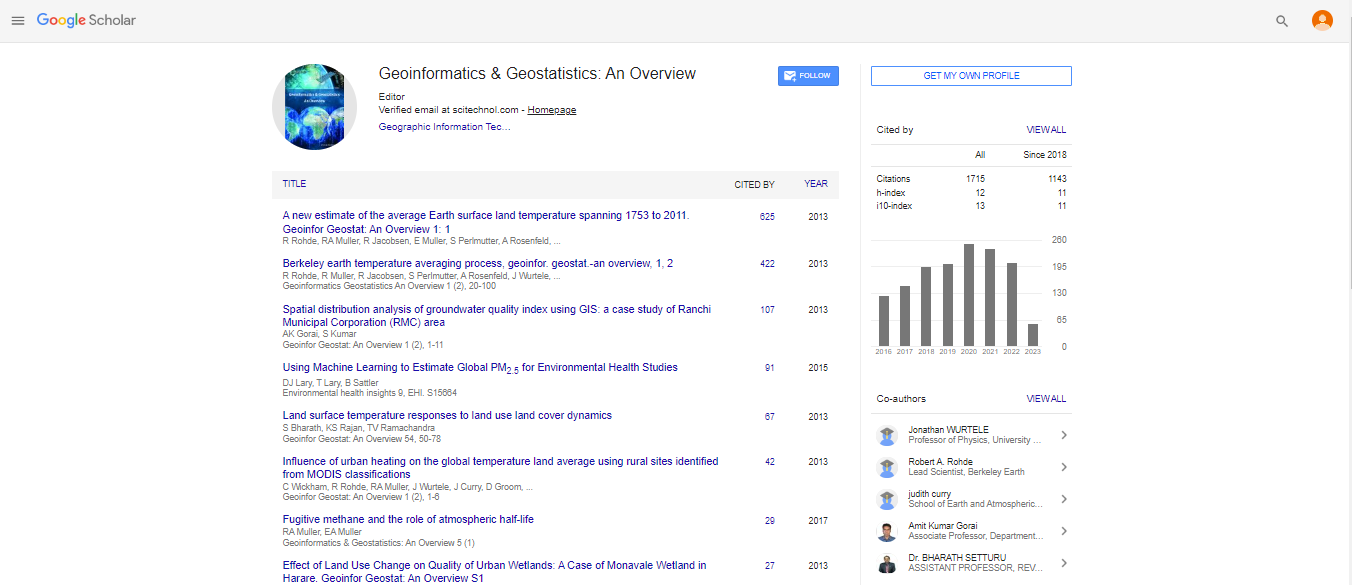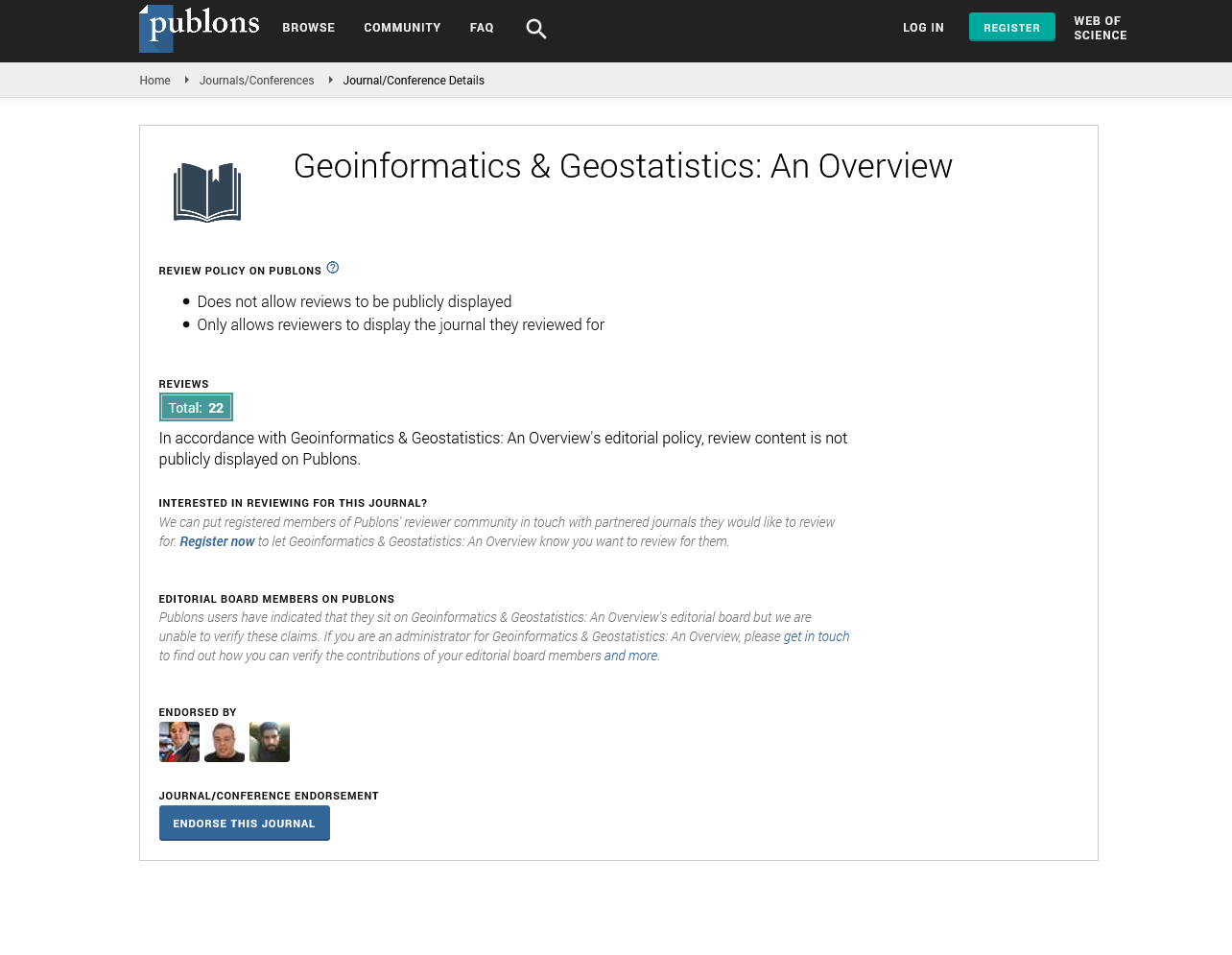Opinion Article, Geoinfor Geostat An Overview Vol: 12 Issue: 6
Geospatial Technologies: Shaping the Future of Urban Planning, Agriculture, and Environmental Management
Dian Zen*
1Department of Remote Sensing and Information Engineering, Wuhan University, Wuhan, China
*Corresponding Author: Dian Zen,
Department of Remote Sensing and Information
Engineering, Wuhan University, Wuhan, China
E-mail: Daix798429636@163.com
Received date: 29 November, 2024, Manuscript No. GIGS-24-156233;
Editor assigned date: 02 December, 2024, PreQC No. GIGS-24-156233 (PQ);
Reviewed date: 16 December, 2024, QC No. GIGS-24-156233;
Revised date: 23 December, 2024, Manuscript No. GIGS-24-156233 (R);
Published date: 30 December, 2024, DOI: 10.4172/2327-4581.1000428.
Citation: Zen D (2024) Geospatial Technologies: Shaping the Future of Urban Planning, Agriculture and Environmental Management. Geoinfor Geostat: An
Overview 12:6.
Abstract
Description
Satellite imagery has revolutionized the way we observe and analyze Earth’s surface. With advancements in satellite technology, imagery now plays a major role in a wide array of fields, including environmental monitoring, urban planning, disaster management agricultural management. This manuscript explores the development of satellite imagery, its applications its significance in modern science and technology. The first significant use of satellites for imagery began in the 1960s, with the launch of the U.S. National Aeronautics and Space Administration's (NASA) Earth-observing satellites. Initially, the technology was limited in scope, with imagery mostly being used for military reconnaissance. However, with the advancement of satellite technology and the rise of commercial satellites, the applications of satellite imagery expanded significantly.
Today, satellites such as Landsat, Sentinel WorldView provide highresolution imagery, offering unprecedented detail and clarity. These advancements have also been aided by the development of various imaging technologies, including multispectral, hyperspectral radar imaging systems. Satellite imagery is vital for monitoring environmental changes, such as deforestation, land degradation the melting of polar ice caps. By comparing images over time, scientists can detect and measure changes in ecosystems, thus providing major data on the impacts of climate change. For instance, the use of remote sensing data from satellites has been instrumental in tracking global temperature variations, sea level rise the shrinking of glaciers.
In urban planning, satellite imagery aids in the analysis of land use, population growth infrastructure development. High-resolution imagery helps urban planners make informed decisions about zoning, transportation networks environmental sustainability. Additionally, satellite data can be used to monitor the growth of cities, assess infrastructure development plan for future urban expansion. Satellite imagery has become an indispensable tool in agriculture. Farmers and agronomists use satellite images to monitor crop health, detect pest infestations estimate crop yields. By analyzing satellite data, farmers can also optimize irrigation schedules and assess soil conditions. Furthermore, imagery helps in precision farming, where specific areas of a field can be treated differently based on their unique conditions, leading to more efficient resource use and higher crop productivity.
Satellites play a major role in disaster management, especially in the aftermath of natural calamities like earthquakes, floods hurricanes. Real-time satellite imagery provides emergency responders with upto- date maps of affected areas, helping them assess damage, plan rescue operations distribute resources. For instance, satellite data is used to predict flood risks by monitoring rainfall patterns and water levels in rivers, thereby enabling early warning systems. Satellite imagery has significant importance in national security and defense applications. Governments and military agencies use satellite data to monitor borders, track military movements gather intelligence on potential threats. The high resolution of modern satellites allows for surveillance over large areas and can even capture detailed imagery of military installations, infrastructure other sensitive sites.
Despite the numerous applications of satellite imagery, there are challenges that must be addressed. One primary concern is the cost of acquiring high-resolution satellite imagery, which can be prohibitively expensive for some organizations and researchers. Additionally, the quality of satellite imagery can be affected by weather conditions, such as cloud cover, which can obscure the Earth's surface and hinder data accuracy. In the future, satellite imagery is expected to become more accessible and affordable due to the growing number of small satellites and advances in cloud-based technologies. The integration of Artificial Intelligence (AI) and Machine Learning (ML) with satellite imagery will further enhance the ability to analyze large datasets, improving accuracy and efficiency in detecting trends and patterns.
Conclusion
Satellite imagery has transformed the way we understand and interact with our planet. From monitoring environmental changes to aiding disaster response and enhancing agricultural productivity, the applications of satellite imagery are vast and varied. As technology continues to evolve, the role of satellite imagery in scientific research and technological advancements will only become more prominent, providing valuable insights that drive global development and sustainability.
 Spanish
Spanish  Chinese
Chinese  Russian
Russian  German
German  French
French  Japanese
Japanese  Portuguese
Portuguese  Hindi
Hindi 
